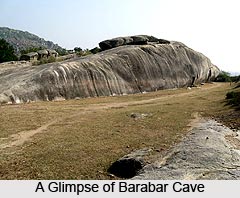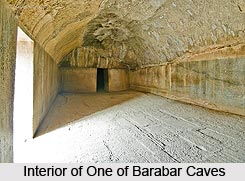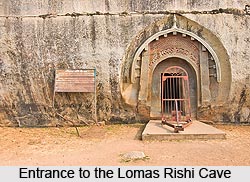 Barabar caves are located in Jehanabad district in Bihar state of India. It can be dated back to the Mauryan period (322-185 BC). These caves are situated in the twin hills of Barabar and Nagarjuni. The Ajivika sect used these caves.
Barabar caves are located in Jehanabad district in Bihar state of India. It can be dated back to the Mauryan period (322-185 BC). These caves are situated in the twin hills of Barabar and Nagarjuni. The Ajivika sect used these caves.
History of Barabar Caves
The Barabar caves consist of two chambers, carved out of granite, with a highly polished internal surface. The first chamber was meant for worshippers in order to meet in a large rectangular hall. The second is a small, circular, domed chamber for worship. Earlier, this inner chamber had a small stupa like structure.
These caves were carved during the first phase of development of Buddhism in the second century BC. These caves are deep and finely cut. Barabar caves are divided in three types and Nagarjuna is one of them. Other two are Hut caves and caves of Pandavas. Nagarjuna caves are situated on Nagarjuna hill which can further be divided into two: Sudama Cave and Chaupar Cave. In some respects, the mouth of one cave - Lomas Rishi Cave resembles the Doors of Durin leading to the Mines of Moria that reflected in the fiction of J. R. R. Tolkien. The ruler of the Maurya Empire, King Ashoka and his son Dasaratha were Buddhists but their state had religious freedom. Several Jain sects and branches flourished in this time among other religious and philosophical trends. One of such trends was Ajivika that is considered by many to be a separate belief - in some respects rather an atheistic movement in philosophy. This deeply ascetic movement originated few centuries earlier together with Buddhism and was characterized by belief in determinism.
In Hinduism and Buddhist sources, practitioners of Ajivika were presented as strict fatalists. The father of Ashoka was believer of this philosophy and during Ashoka`s time it reached its peak of popularity. This belief has not survived up to this day and in fact there is little known about it. Unfortunately, no original scriptures of this ancient philosophy have survived.
 The gigantic monolith of Barabar cliff north from the Punpun River near its mouth in Phalgu River resembles a dark, sinister submarine rising from the soil. It is located at the base of the 300 meters high Siddheshwar Mountain - interesting place with a later Lord Shiva Temple and remnants of fortification on its top and some ancient cliff carvings as well. Barabar cliff is approximately 200 meters long and contains several very interesting monuments of history, notably - four rock-cut caves. These caves are hewn out in the very hard monolithic stone. There are three caves that have two chambers. First chamber is large, rectangular hall (mandapa), here the worshippers used to gather. Second chamber is smaller, circular, with domed ceiling. This was a place of worship, possibly with some sanctum (like stupa) in the centre. Now these chambers are empty. It has been speculated that these circular premises have been inspired by the ancient beehive houses.
The gigantic monolith of Barabar cliff north from the Punpun River near its mouth in Phalgu River resembles a dark, sinister submarine rising from the soil. It is located at the base of the 300 meters high Siddheshwar Mountain - interesting place with a later Lord Shiva Temple and remnants of fortification on its top and some ancient cliff carvings as well. Barabar cliff is approximately 200 meters long and contains several very interesting monuments of history, notably - four rock-cut caves. These caves are hewn out in the very hard monolithic stone. There are three caves that have two chambers. First chamber is large, rectangular hall (mandapa), here the worshippers used to gather. Second chamber is smaller, circular, with domed ceiling. This was a place of worship, possibly with some sanctum (like stupa) in the centre. Now these chambers are empty. It has been speculated that these circular premises have been inspired by the ancient beehive houses.
Different Barabar Caves
There are four caves in the Barabar Caves. The northern side of the hill contains cave named Karan Chaupar with floor area of 10 x 4.2 meters. The barrel vault over the chamber is up to 3.3 m high. At the western end of the room there is platform - the only unpolished detail. To the right from the entrance there are traces of inscription from 245 BC. Further to the west in unknown times, there are hewn two human figures and lingam in the smooth surface of stone. Southern side of the hill has two very interesting caves.
Lomas Rishi
Lomas Rishi is one of the oldest rock-cut chambers in India. It consists of rectangular, partly polished mandapa - with unfinished barrel vault, through the doorway connected to a circular, domed, unpolished chamber. The cave has interesting, arch-shaped entrance portal, imitating a wooden structure of time. The doorway is adorned with a pageant of elephants going upwards to the Stupa Symbol adorning the keystone of arch. The cave contains inscription from later times - 7th - 8th century AD referring to kings Sarddulavarman and his son Anantarvarman, Maukhari dynasty. The inscription mentions, that Anantarvarman placed an image of Lord Krishna in the cave. Above this cave in 1914, there was discovered an inscription which names the hill - Gorathagiri. The name is mentioned in Mahabharata.
 Sudama Cave
Sudama Cave
Sudama Cave is another oldest cave in complex, located opposite the Karan Chaupar and close to Lomas Rishi. The entrance of this cave is simple, functional. It consists of two rooms. The first is the Mandapa. It is 10 X 6 m large, barrel vault up to 3.5 m high. Through a doorway, it is connected to a circular, domed chamber with diameter of 6 m. At the eastern end of mandapa there is shallow, roughly shaped recess - most likely unfinished extension. According to inscription in ancient Brahmi writing, the cave is dedicated by Ashoka in 12th year of his reign (261 BC). The cave is named "Nigoha-Kubha" that is the "banyan tree cave". This cave has the most amazing polishment, and it feels as if the cave has been layered with a sheet of glass. Most likely this cave in earlier times had more complex entrance portal - excavations have unearthed pieces of pillars.
Visva Zopri
Visva Zopri can be reached by simple steps cut in stone - "Ashoka Steps" 500 - 1000 meters north-west from the other three caves in south-facing cliff face. Entrance in the cave is simple, square cut. Walls of cave are not polished. This cave also has two chambers - both have approximately cubical form and are connected through a doorway. Both cubes have approximately 2 m long sides.
Many Jataka stories have been portrayed on the walls of these caves, which are relevant to understand the development of Buddhism in various phases. These caves have magnanimous arches. Choper is a single chambered structure with a vaulted roof and small gate. The arches of Sudama cave are of bow shape. Halls were made in circular shape. There are two chambers inside the Sudama cave that are highly sophisticated. The Barabar caves are open from one side while closed from three sides. Most of them are in the shape of a cottage or hut.



















